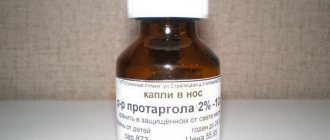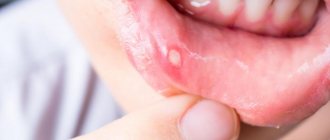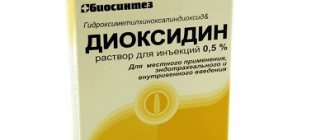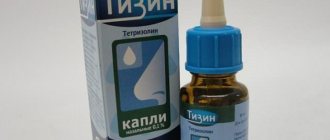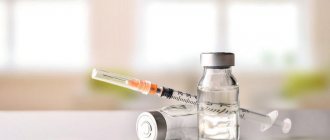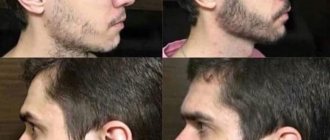Stomatidin is a popular local antiseptic that is used to treat and prevent infections of the mouth and pharynx. The drug has an antiseptic, anti-inflammatory, mild analgesic effect. The solution is effective against many gram-positive and gram-negative bacteria and fungi.
Stomatidin has a minimum of contraindications and rarely causes adverse reactions. To get only the benefits of the solution, you need to read the instructions and follow the rules for its use: method, dose, frequency, course duration. And reviews from patients who have tested the antiseptic themselves will help you make a quicker choice.
Composition and release form
The antimicrobial drug is presented in the pharmacy in the form of a solution for topical use. This clear red liquid is packaged in dark glass bottles. The volume of the bottle is 200 ml, it is in a cardboard package. Stomatidin is also sold in aerosol form in a bottle (200 ml) with a sprayer.
The main component of the antiseptic is hexetidine. 100 ml of the drug contains 100 mg of active substance. Additional
Components of Stomatidin:
- propylene glycol;
- polysorbate 20 (E432);
- food additive E330;
- saccharin;
- racementol;
- salicylic acid methyl ester;
- food additive E112;
- ethyl alcohol 96%;
- purified water.
Auxiliary components enhance the effect of hexetidine.
STOMATIDINE
Drug: STOMATIDINE Active substance: hexetidine ATC code: A01AB12 KFG: Antiseptic for topical use in ENT practice and dentistry ICD-10 codes (indications): A69.1, B37.0, J02, J03, J31, J35. 0, K05, K12, R19.6 Reg. number: P No. 015357/01 Registration date: 12.12.08 Owner reg. ID: BOSNALIJEK (Bosnia and Herzegovina)
DOSAGE FORM, COMPOSITION AND PACKAGING
◊ Solution for topical use 0.1% is transparent, red, with a characteristic odor, foams when shaken.
| 100 ml | |
| hexetidine | 100 mg |
Excipients: propylene glycol, polysorbate, citric acid monohydrate, sodium saccharin, menthol, methyl salicylate, azorubine CL 14720, ethanol 96%, purified water.
200 ml - dark glass bottles (1) - cardboard packs.
INSTRUCTIONS FOR USE FOR SPECIALISTS.
Description of the drug was approved by the manufacturer in 2007. PHARMACOLOGICAL ACTION
Antiseptic drug for topical use in ENT practice and dentistry. Hexetidine has an antimicrobial and weak analgesic effect on the oral mucosa.
INDICATIONS
- infectious and inflammatory diseases of the oral cavity and pharynx: tonsillitis (including Vincent's angina), pharyngitis, gingivitis, bleeding gums, periodontitis, stomatitis, glossitis, aphthous ulcers;
- to prevent infection of the alveoli after tooth extraction;
- fungal infections of the oral cavity and pharynx (especially candidal stomatitis before and after operations);
- injuries to the oral cavity and pharynx;
- as a deodorizing agent to eliminate bad breath;
- for the prevention of superinfections in the case of tumors of the oral cavity and pharynx in the stage of decay.
DOSING REGIME
For diseases of the oral cavity and pharynx, you should rinse your mouth with 10-25 ml of undiluted Stomatidin solution for 0.5 minutes. Rinsing is carried out 2 times a day, preferably in the morning and evening after meals. If necessary, more frequent use of the drug is possible.
The drug is intended for topical use only (the solution should not be swallowed!). For rinsing, you should always use an undiluted solution; when treating diseases of the oral cavity, it can also be applied using a tampon.
SIDE EFFECT
In some cases: hypersensitivity reactions; with long-term use - taste disturbance.
CONTRAINDICATIONS
- children under 4 years of age;
- hypersensitivity to the components of the drug.
PREGNANCY AND LACTATION
There is no data on the negative effects of using the drug Stomatidin during pregnancy and lactation (breastfeeding).
SPECIAL INSTRUCTIONS
The drug can be prescribed only if the patient is able to spit out the solution after rinsing.
If signs of hypersensitivity to hexetidine appear, the drug should be discontinued immediately.
OVERDOSE
Cases of overdose of the drug Stomatidin have not been described.
DRUG INTERACTIONS
When using the solution according to indications and in recommended doses, interaction with other drugs is not expected.
CONDITIONS OF VACATION FROM PHARMACIES
The drug is approved for use as a means of OTC.
CONDITIONS AND DURATION OF STORAGE
The drug should be stored out of the reach of children at a temperature not exceeding 30°C. Shelf life: 2 years.
Effect of the drug
How does Stomatidin work? Instructions for use provide information that the drug has a pronounced antiseptic and deodorizing effect. The solution suppresses the activity of pathogenic microorganisms (bacteria, fungi), stops their development, destroys or muffles the foul odor.
Stomatidin helps stop or weaken the inflammatory process, as well as discomfort in the oral cavity and pharynx. Hexetidine begins to act within 2 to 5 minutes after application. Stomatidin solution washes out 90 - 92% of pathogenic microorganisms and their toxins. At the same time, Stomatidin does not inhibit the natural microflora of the oral cavity.
Pharmacodynamics and pharmacokinetics
The local antiseptic Stomatidin is actively used by otolaryngologists and dentists. It demonstrates a complex effect: antibacterial, antifungal, anti-inflammatory, mild analgesic, deodorizing.
Hexetidine is effective against gram-positive and gram-negative bacteria (Pseudomonas aeruginosa, Proteus mirabilis), and fungi of the genus Candida. This substance suppresses the activity and stops the reproduction of Trichomonas.
Hexetidine suppresses the formation of thiamine, which is necessary for the proliferation of harmful microflora. That is, this substance is a thiamine antagonist. Stomatidin disrupts the metabolism of microbial cells by inhibiting oxidative reactions in them. The solution weakens or eliminates inflammation, reduces pain, and accelerates the regeneration of mucous membranes. When used regularly, it reduces the incidence of tooth decay and also freshens breath.
At low concentrations, the drug demonstrates a pronounced bactericidal effect. There is no information on the development of resistance of pathogenic microorganisms to Stomatidin.
When applied topically, Stomatidin solution is quickly absorbed into the mucous membrane. It is evenly distributed throughout the tissues of the oral cavity and pharynx, quickly exhibiting a therapeutic effect that lasts for 65 - 72 hours. In the interdental space, a high concentration of hexetidine is maintained from 10 to 14 hours.
Stomatidin does not exhibit a systemic effect, since when used correctly it does not enter the bloodstream. Excess drug is excreted along with saliva.
Indications for use
Let's consider in what cases it is recommended to use Stomatidin. Instructions for use state that the solution is prescribed for the treatment of inflammatory pathologies of the oral cavity:
- tonsillitis (various forms of pathology, including inflammation of the lateral ridges or ulcerative membranous);
- pharyngitis (inflammation of the pharynx);
- gingivitis (inflammatory disease of the gums);
- bleeding from the gums;
- periodontopathies;
- stomatitis (inflammation of the oral mucosa, the appearance of ulcers);
- glossitis (inflammatory lesion of the tongue);
- fungal infection of the oral cavity or pharynx (especially stomatitis caused by fungi of the genus Candida).
Stomatidin is used to prevent superinfection in the presence of aphthous ulcers. The solution helps prevent infection of the alveoli after tooth extraction. The medicine is used before and after surgery in the oral cavity and pharynx to avoid postoperative complications. The drug is an important component of complex therapy for common diseases, as it ensures oral hygiene. It also helps get rid of halitosis (bad breath). For this purpose, Stomatidin is used in the presence of malignant tumors of the oral cavity.
Description and instructions for the drug Stomatidin
Stomatidin is a disinfectant used for rinsing the throat and mouth.
Some other medications, such as Hexoral, contain the same active ingredient as this drug. This component is called hexetidine. It is capable of destroying bacteria and fungi (mainly gram-positive microorganisms and proteus and candida fungi). Thanks to this compound, Stomatidin has the ability to envelop, destroy odors, stop micro-bleeding, and relieve pain. Treatment with this drug can be indicated for various infectious and inflammatory diseases of the oral cavity and nasopharynx. In addition, Stomatidin is often used to prevent the development of such conditions. Stomatidin is used for:
- Tonsillitis, stomatitis, glossitis and other inflammations of the mucous membranes of the mouth and pharynx;
- Fungal infections such as thrush;
- Injuries to the oral mucosa, after tooth extraction and other operations - as a disinfectant and prophylactic agent;
- Disintegration of tumors localized in the oral cavity and pharynx;
- Need to remove bad breath.
Stomatidin is produced in the form of a solution for rinsing or applying to the mucous membrane with a tampon. This solution does not need to be diluted before the procedure. The instructions for the drug Stomatidin indicate that two rinses per day are standard, but, as prescribed by a doctor, according to indications, this number of uses can be increased. It is important to know in advance that the solution should not be swallowed. This is worth remembering especially when gargling with Stomatidin.
Stomatidin is contraindicated for:
- Allergies to hexetidine;
- Treatment of children under four years of age.
Side effects and overdose of Stomatidin
As with any drug, there is a possibility of intolerance to this solution. If you use Stomatidin for a long time and incontinently, your sense of taste may suffer.
Instructions for use
The solution is used topically as a mouth rinse. There is no need to dilute the medicine with water; its concentration is safe for use in its pure form. The patient must take the required dose of medication into the mouth and spit out the liquid after rinsing. You can't swallow it.
Stomatidin solution (0.1%) is used for rinsing after prescription by a doctor, who will determine the dose, frequency and duration of treatment. Usually the treatment procedure is carried out after eating. You need to take 10 - 15 ml of the medicine in its pure form, rinse for 30 seconds, and then spit it out. This method is used to treat oral diseases in patients over 6 years of age. It is possible to use the solution in a targeted manner, for example, for stomatitis, alveolitis (inflammation of the wall of the socket of an extracted tooth). Then the patient carefully applies the drug using a tampon to the sites of infection.
If there are ulcers, you can apply lotions. Then a swab soaked in the medicine is applied to the affected area for 30 seconds.
Use Stomatidin for rinsing twice a day (after breakfast and after dinner), and for targeted use - from 2 to 5 times. The duration of the course is determined by the doctor individually, taking into account the diagnosis, age, and characteristics of the body.
The aerosol helps to quickly relieve pain in the mucous membranes when a person cannot rinse his mouth or throat. It is enough to press the sprayer once. The frequency of application of the spray is 3 or 4 times a day.
After using the drug, you should not eat for 2 to 3 hours.
If 5 days after the start of therapy, symptoms of diseases of the oral cavity or pharynx have not disappeared, then you should consult an otolaryngologist or dentist.
Analogs of Stomatidin solution
Last price update: 05/29/2020 (150+ cities and 12,000+ pharmacies)
Website: doktorfrolov.ru, Phone ☎, E-mail: [email protected]
List of analogues: sorting by price, rating
Stomatidin (solution) Rating: 10 votes
List of available analogues of Stomatidin
Analogue is cheaper from 282 rubles.
Chlorhexidine (analogue) is a domestic drug, produced in the form of an aqueous and alcoholic solution for local and external use in 100 ml bottles, as well as a spray in 100 ml bottles. The medicine destroys and neutralizes most gram-positive and gram-negative microbes, some viruses, fungi and protozoa. Used for the treatment of infectious and inflammatory diseases of the oral cavity, ENT organs, skin and mucous membranes, soft tissues, and genitourinary system organs. May cause irritation at the site of application, rash and itching of the skin, cough, sneezing, rhinorrhea, bronchospasm, Quincke's edema, anaphylactic shock, stickiness of the skin of the hands, taste disturbance, staining of tooth enamel, tartar deposits. Do not use the medicine if you are intolerant to it. Caution should be exercised when used in children, pregnant and lactating women.
Ingalipt → substitute Rating: 4 votes Top
Analogue is cheaper from 227 rubles.
Ingalipt (analogue) is a domestic medicine, available in the form of a spray and aerosol for local use in bottles of 30 and 45 ml. The mechanism of action of the drug is similar to the above drugs. It is used as an antimicrobial, anti-inflammatory and mild local anesthetic for infectious and inflammatory diseases of the oral cavity, pharynx, larynx, tonsils, gums, tongue, teeth. Use the medicine topically (inhalation) three to four times a day after preliminary rinsing the mouth. May cause local and general allergic reactions in the form of immediate and delayed hypersensitivity. The drug is contraindicated in case of hypersensitivity to its components.
Dentamet (dental gel) → substitute Rating: 4 votes Top
Analogue is cheaper from 167 rubles.
Dentamet (analog) - produced by Russian pharmaceuticals in the form of a 25 g dental gel. This is a local antiseptic drug that affects most gram-positive and gram-negative microbes, and also relieves inflammation, redness, swelling, and pain. It is used for stomatitis, gingivitis, glossitis, periodontitis, pulpitis, aphthous stomatitis, periodontal abscesses, bleeding gums, bad breath, to prevent secondary infection after tooth extraction, trauma, surgery, burns of the oral cavity, to prevent superinfections after oral tumors. May cause a “metallic” taste in the mouth, local and general allergic reactions in the form of immediate and delayed hypersensitivity. Contraindicated in case of idiosyncrasy. It is undesirable to use in women during pregnancy and breastfeeding.
Sebidin (lozenges) → substitute Rating: 1 votes Top
Analogue is cheaper from 142 rubles.
Sebidin (analogue) is a drug produced in Russia and Poland in the form of lozenges (No. 20). The medicine destroys and inactivates most gram-positive and gram-negative microorganisms, affects some viruses and fungi, and has an anti-inflammatory and weak local anesthetic effect. Used to treat sore throats, tonsillitis, pharyngitis, laryngitis, gingivitis, cheilitis, glossitis, periodontitis, periodontal disease, aphthous stomatitis, and to eliminate bad breath. It is used to prevent infectious and inflammatory processes in the oral cavity after tooth extraction, trauma, burns, and oral surgery. May cause local reactions, skin rash and itching, cough, sneezing, rhinorrhea, angioedema, bronchospasm, anaphylactic shock, discomfort in the mouth, nausea, vomiting, pain and bloating, belching, stool disorders. Contraindicated in case of idiosyncrasy.
Analogue is cheaper from 99 rubles.
Metrogyl Denta (analogue) is a medicine produced in Russia and India, produced in the form of a dental gel in tubes of 20 g. The medicine affects most microorganisms that cause diseases of the oral cavity. It is used to treat diseases of the oral cavity, such as acute and chronic gingivitis, glossitis, periodontitis, periodontal disease, aphthous stomatitis, cheilitis, periodontal abscess. It is also used to prevent infectious and inflammatory processes in the oral cavity after operations, injuries, and tooth extraction. Can be used in children over six years of age. Apply the gel twice a day for a course of one week to ten days. May cause headache, irritation at the site of application, local and general allergic reactions such as immediate and delayed hypersensitivity. Cannot be used if intolerant, or for children under six years of age.
Side effects
Let's look at what side effects Stomatidin can cause. The instructions for use describe that the solution rarely causes negative reactions even after long-term treatment. However, there is a risk of side effects:
- local dryness, burning of the mucous membrane, discomfort or pain, numbness;
- allergic reactions in the form of redness, rash, itching, extremely rarely - bronchospasm, Quincke's edema;
- impaired perception of taste or smell.
Some patients complain that after using Stomatidin, the tongue and teeth become stained.
An allergy indicates increased sensitivity to the components of the drug, then you need to stop taking it. The doctor will help you choose a more appropriate remedy. All other adverse reactions disappear after use.
Contraindications and side effects
In accordance with the instructions for use, Stomatidin is contraindicated:
- in the 1st trimester of pregnancy;
- children under 5 years old;
- with individual intolerance;
- with pharyngitis, accompanied by atrophic changes in the throat mucosa.
The manufacturer notes that in some patients the drug causes the following side effects:
- burning and noticeable irritation at the site of application;
- dry mucous membrane;
- allergic reactions.
Topical preparations containing hexethidine may cause changes in taste perception when used daily. These changes are reversible.
Stomatidine for children
Children under 6 years of age should not use Stomatidin to treat oral infections for the following reasons:
- does not have the skill of rinsing;
- may swallow the solution.
After swallowing the components, the drug will penetrate through the mucous membranes into the bloodstream. This will lead to nausea and vomiting. Then you will have to rinse your stomach.
Despite the ban, doctors prescribe the drug to children under 6 years of age. For example, with a sore throat, a child gargles not his throat, but his mouth. In this case, the risk of swallowing the medicine is lower. After spitting, some of the liquid remains in the mouth, and when the child swallows saliva, it ends up on the inflamed tissues of the throat. The drug has a therapeutic effect on the affected area.
Very young children can apply the drug with a tampon to certain areas.
The standard dose is 15 ml for 30 seconds twice a day. Although the final dose, frequency and duration of therapy is determined by the pediatrician.
Directions for use and doses
Locally.
- To rinse, you should always use undiluted product. The solution should not be swallowed. It is necessary to spit out the solution after rinsing.
- For diseases of the oral cavity in adults and children over 5 years of age, rinse the mouth with 10–15 ml (1 tablespoon) of an undiluted solution of the drug for 30 seconds.
- For throat diseases in adults and children over 5 years of age, rinse with the same amount of undiluted solution of the drug for 30 seconds.
- When treating diseases of the oral cavity, the drug can be applied using a tampon. Apply 2 times a day (preferably morning and evening), after meals. The duration of use of the drug is determined individually. If symptoms of the disease do not disappear after 5 days of using the drug and/or are accompanied by fever, you should consult a doctor.
Locally.
To rinse, you should always use undiluted product. The solution should not be swallowed. It is necessary to spit out the solution after rinsing.
For diseases of the oral cavity in adults and children over 5 years of age, rinse the mouth with 10–15 ml (1 tablespoon) of an undiluted solution of the drug for 30 seconds.
For throat diseases in adults and children over 5 years of age, rinse with the same amount of undiluted solution of the drug for 30 seconds.
When treating diseases of the oral cavity, the drug can be applied using a tampon.
Apply 2 times a day (preferably morning and evening), after meals. The duration of use of the drug is determined individually. If symptoms of the disease do not disappear after 5 days of using the drug and/or are accompanied by fever, you should consult a doctor.
Stomatidin is applied topically.
When rinsing, you should always use an undiluted solution.
The drug should not be swallowed; after the procedure, it should be spat out.
Recommended regimen for using the drug in the treatment of diseases of the oral cavity and pharynx (throat): rinse for 30 seconds, single dose – 10–25 ml (1 tablespoon).
For diseases of the oral cavity, Stomatidin solution can be applied using a tampon.
The frequency of use of the drug is 2 times a day, after meals, preferably in the morning and in the evening.
The duration of the treatment course is determined by the doctor individually.
If after 5 days of therapy the symptoms of the disease do not go away and/or are accompanied by fever, you should consult a doctor for advice.
During pregnancy and breastfeeding
Stomatidin is contraindicated in pregnant women who have not yet reached the 13th week. The components of the drug are practically not absorbed into the bloodstream, but remain on the mucous membrane. But studies have not been conducted to prove that hexetidine does not cross the placenta. It should also be taken into account that 1 dose of solution contains 15 mg of the main component. And this is 10 times more than in one spray of aerosols based on hexetidine, for example, Hexoral, Stopangin. In addition, the medicine contains a considerable amount of ethanol.
After the 13th week of pregnancy, Stomatidin solution can be used for medical reasons.
To minimize potential harm, the expectant mother can apply the drug pointwise rather than gargle with it.
There is no information on the penetration of Stomatidin components into breast milk. For this reason, doctors do not recommend using the medicine for this category of patients. During the period of treatment it is necessary to stop breastfeeding. After completion of therapy, lactation is resumed.
special instructions
Stomatidin is allowed to be used after a doctor's prescription. Despite its apparent safety, it can cause harm.
The drug should not be used by patients who cannot rinse their mouth or throat for some reason. If the inflammatory process intensifies, you should stop treatment with the solution or spray. It is also worth doing if symptoms of an allergy to the components of Stomatidin appear.
The medicine is used with caution by patients with epilepsy. It can reduce the epileptic threshold of activity and cause seizures in children. Only after consulting a doctor, the drug is included in the treatment regimen for patients with a tendency to allergic reactions (especially allergies to acetylsalicylic acid) and asthma.
Due to the presence of ethanol in the composition, Stomatidin is used under medical supervision by patients with liver diseases. For the same reason, you need to take the drug at least half an hour before work related to concentration and reaction speed (including driving a car).
Shelf life, storage and sales conditions
Stomatidin can be stored for 2 years in a closed bottle. After opening the package, the shelf life is reduced to 6 months. Do not use expired medications.
The optimal temperature for storing a solution or spray is up to +25˚. Freezing the medicine is prohibited. It is important to keep it out of the reach of children.
Stomatidin is sold in pharmacies without a prescription. However, before purchasing the drug, you need to consult with your doctor, who will decide on the advisability of its use.
Analogs
This group includes drugs that contain various active substances with Stomatidin, but are also used to treat infections of the oral cavity and pharynx.
Analogues of Stomatidin:
- Medacept based on ethanol has an antiseptic and irritating effect. Not prescribed for children under 14 years of age or for acute skin inflammation.
- Hexicon with chlorhexidine bigluconate perfectly disinfects, but does not affect acid-resistant pathogenic microorganisms.
- Decathylene with dequalinium chloride stops the development of bacteria, fungi, and relieves pain.
- Givalex, based on benzyldimethyl ammonium chloride monohydrate, inhibits the development of pathogens.
- Faringosept with ambazon is effective against streptococci, staphylococci, and pneumococci. Can be used as monotherapy.
If there are contraindications to hexetidine, the solution can be replaced with the drugs described above.
Stomatidin analogues
This page provides a list of all Stomatidin analogues by composition and indication for use. A list of cheap analogues, and you can also compare prices in pharmacies.
- The cheapest analogue of Stomatidin: Parodontocide
- The most popular analogue of Stomatidin: Hexoral
- ATC classification: Hexetidine
- Active ingredients/composition: hexethidine
| # | Name | Price in Russia | Price in Ukraine |
| 1 | Parodontocide is a combination of many active ingredients. Analogue according to indications and method of use. | 60 rub | — |
| 2 | Proposol-N propolis Analogue according to indications and method of use | 61 RUR | 20 UAH |
| 3 | Dentamet metronidazole, chlorhexidine gluconate Analogue according to indications and method of administration | 103 RUR | 184 UAH |
| 4 | Proposol propolis Analogue according to indications and method of use | 105 RUR | 19 UAH |
| 5 | Metrodent metronidazole, chlorhexidine Analogue according to indications and method of use | 122 rub. | 1 UAH |
When calculating the cost of cheap analogues of Stomatidin, the minimum price was taken into account, which was found in the price lists provided by pharmacies
| # | Name | Price in Russia | Price in Ukraine |
| 1 | Hexoral hexethidine Analogue in composition and indication | 132 rub. | 1 UAH |
| 2 | Metrogyl Denta metronidazole, chlorhexidine Analogue according to indications and method of use | 171 RUR | 27 UAH |
| 3 | Parodontocide is a combination of many active ingredients. Analogue according to indications and method of use. | 60 rub | — |
| 4 | Dentamet metronidazole, chlorhexidine gluconate Analogue according to indications and method of administration | 103 RUR | 184 UAH |
| 5 | Proposol-N propolis Analogue according to indications and method of use | 61 RUR | 20 UAH |
This list of drug analogues is based on statistics of the most requested drugs
All analogues of Stomatidin
Analogues in composition and indications for use
| Name | Price in Russia | Price in Ukraine |
| Hexoral hexetidine | 132 rub. | 1 UAH |
| Hexosept hexetidine | — | 25 UAH |
| Maxicold Lor Hexetidine | 151 RUR | 261 UAH |
| Stomolik hexetidine | — | 39 UAH |
The above list of drug analogues, which indicate substitutes for Stomatidin , is the most suitable, since they have the same composition of active ingredients and coincide in indications for use
Analogues by indication and method of use
| Name | Price in Russia | Price in Ukraine |
| Metrodent metronidazole, chlorhexidine | 122 rub. | 1 UAH |
| Periochip chlorhexidine | — | 8676 UAH |
| Proposol propolis | 105 RUR | 19 UAH |
| Proposol-N propolis | 61 RUR | 20 UAH |
| Proposol-KM propolis | — | 21 UAH |
| Metroviol Denta metronidazole, chlorhexidine | — | 11 UAH |
| Proposol-Health propolis | — | 23 UAH |
| Dental gel Health metronidazole, chlorhexidine | — | 21 UAH |
| Dentamet metronidazole, chlorhexidine gluconate | 103 RUR | 184 UAH |
| Parodontocide is a combination of many active ingredients | 60 rub | — |
| Septalor ascorbic acid, chlorhexidine | — | 19 UAH |
| Dentagel metronidazole, chlorhexidine | — | 13 UAH |
| Metrogyl Denta metronidazole, chlorhexidine | 171 RUR | 27 UAH |
Different composition, may have the same indication and method of use
| Name | Price in Russia | Price in Ukraine |
| Tantum Verde benzydamine | 152 rub. | 67 UAH |
| T-Sept benzydamine | — | 39 UAH |
| Forteza benzydamine | — | 87 UAH |
| AngiDac benzydamine | 166 RUR | 450 UAH |
| Oralcept benzydamine hydrochloride | 143 RUR | 400 UAH |
| Zipelor benzydamine | — | 83 UAH |
| Zipelor Forte benzydamine | — | 94 UAH |
| Tantum Verde forte Benzydamine hydrochloride | 174 RUR | — |
| Bronflex Benzydamine | 223 RUR | — |
| Dentinox gel n lidocaine, polidocanol 600, Chamomile officinalis | — | 55 UAH |
| Dentokind homeopathic potencies of various substances | 460 rub. | 110 UAH |
| Oak bark Common oak | 23 rub. | 4 UAH |
| St. John's wort tincture | — | — |
| Calgel lidocaine hydrochloride, cetylpyridinium chloride | 277 RUR | 400 UAH |
| Kamistad lidocaine, chamomile flower extract | 196 RUR | 42 UAH |
| Maraslavin cloves, ginger, black pepper, wormwood, savory | 75 RUR | 65 UAH |
| Rotokan calendula officinalis, chamomile, yarrow | 14 rub. | 14 UAH |
| Solcoseryl dental adhesive paste deproteinized hemoderivative from calf blood, polidocanol 600 | 481 RUR | 114 UAH |
| Stomatophyte Calamus, Arnica montana, Common oak, Peppermint, Chamomile, Common thyme, Salvia officinalis | 108 rub. | 46 UAH |
| Stomatophyte A Calamus, Arnica montana, benzocaine, Common oak, Peppermint, Chamomile, Common thyme, Salvia officinalis | 131 RUR | 54 UAH |
| Cholisal choline salicylate, cetalkonium chloride | 117 RUR | 62 UAH |
| Sage leaves Salvia officinalis | 34 rub. | 7 UAH |
| Phytosept Capsicum | 70 rub | 7 UAH |
| Phytocan | — | 30 UAH |
| Phytodent Calamus, Calendula officinalis, Stinging nettle, Chamomile, Sophora japonica, Celandine, Rosehip | — | 22 UAH |
| Bronspray Peppermint, Common Thyme, Salvia officinalis | — | 40 UAH |
| Denta camphor, chloral hydrate | — | 7 UAH |
| Dental drops Valerian officinalis, camphor, peppermint | 12 rub. | 2 UAH |
| Kamident-Health lidocaine, Chamomile, thymol | — | 25 UAH |
| Kamistad-gel N lidocaine, Chamomile officinalis | — | 41 UAH |
| Phytocan-GNCLS Calendula officinalis, Chamomile officinalis, Yarrow | — | 39 UAH |
| Eucalyptus leaves | 47 RUR | 7 UAH |
| Eucalyptus tincture | 9 RUR | 2 UAH |
| Salvia Salvia officinalis | 19 rub. | 6 UAH |
| Anginophyte | — | — |
| Novosept Forte | — | — |
| Dentinox chamomile extract, lidocaine hydrochloride monohydrate, polidocanol | 273 RUR | 55 UAH |
| Holisal Dental is a combination of many active ingredients | 117 RUR | — |
| Kamistad Baby is a combination of many active ingredients | 196 RUR | — |
| Sage Natur Product Flavonoids, Sage, Menthol | 138 RUR | — |
| Lident baby Lidocaine hydrochloride, Cetylpyridinium chloride | — | — |
| Stomatofit Expert Salvia officinalis leaves, Chamomile flowers, Peppermint leaves, Arnica flowers, Oak bark, Thyme herb extract, Calamus rhizomes | 238 RUR | — |
| Dentaguttal Tincture of rhizomes with roots of Valerian officinalis, Peppermint oil, Camphor | 23 rub. | — |
| Mundizal Choline salicylate | 1950 rub. | — |
How to find a cheap analogue of an expensive medicine?
To find an inexpensive analogue of a medicine, a generic or a synonym, first of all we recommend paying attention to the composition, namely the same active ingredients and indications for use. The same active ingredients of a drug will indicate that the drug is a synonym for the drug, pharmaceutically equivalent or a pharmaceutical alternative. However, we should not forget about the inactive components of similar drugs, which may affect safety and effectiveness. Do not forget about the instructions of doctors; self-medication can harm your health, so always consult a doctor before using any medication.
Stomatidin price
On the websites below you can find prices for Stomatidin and find out about availability at a pharmacy near you
Stomatidin instructions
Synonyms
If Stomatidin is not available in the pharmacy, the patient can purchase its synonym - a drug with the same active ingredient, but with different trade names.
Synonyms of Stomatidin:
- Hexoral has a disinfecting, analgesic, and deodorizing effect. The price starts from 153 rubles.
- Stopangin Teva stops the development of pathogenic microorganisms and relieves inflammation. Cost – from 200 rubles.
- Maxicold ENT relieves pain and inhibits the growth of bacteria and fungi. Starting price – 205 rubles.
- Gelangin Flex has antimicrobial and antiviral effects. The drug costs from 230 rubles.
- Gelangin Nova has a wide spectrum of antibacterial and antifungal effects. Price – from 239 rubles.
All of the above drugs contain hexetidine as the main component and have the same effect.
They are completely interchangeable and differ only in price.
The use of generics should be agreed with the attending physician.
Analogues of Stomatidin
If a child has a disease of the oral or nasopharyngeal mucosa, but is not yet 5 years old, then Stomatidin analogues can be used. These include: Hexoral, Maxicold ENT.
These drugs contain hexatidine, and their mode of action is similar to that of Stomatidine.
The drug Hexoral contains additional substances: extracts of eucalyptus, mint, cloves, orange. They add sweet taste and auxiliary medicinal properties to drugs. Stomatidin analogues contain alcohol in smaller quantities. There are a variety of forms: solutions, tablets, sprays.
Characteristic features of analogues:
- Hexoral. It comes in the form of a solution, spray, tablets. The medicine is an antiseptic and provides antimicrobial and deodorizing effects. Fights against fungal diseases. The mechanism of action is to destroy the shell of microbes and weaken oxidation reactions. Hexoral is used in the treatment of children who are already 3 years old.
- Maxicold ENT. It comes in the form of a solution and spray. A distinctive feature is its analgesic effect. Fights germs and fungi. Approved for the treatment of children over 3 years of age.
Thus, Stomatidin is a good medicine, but it is approved only for children over 5 years of age. Therefore, if necessary, you can use its analogues.

